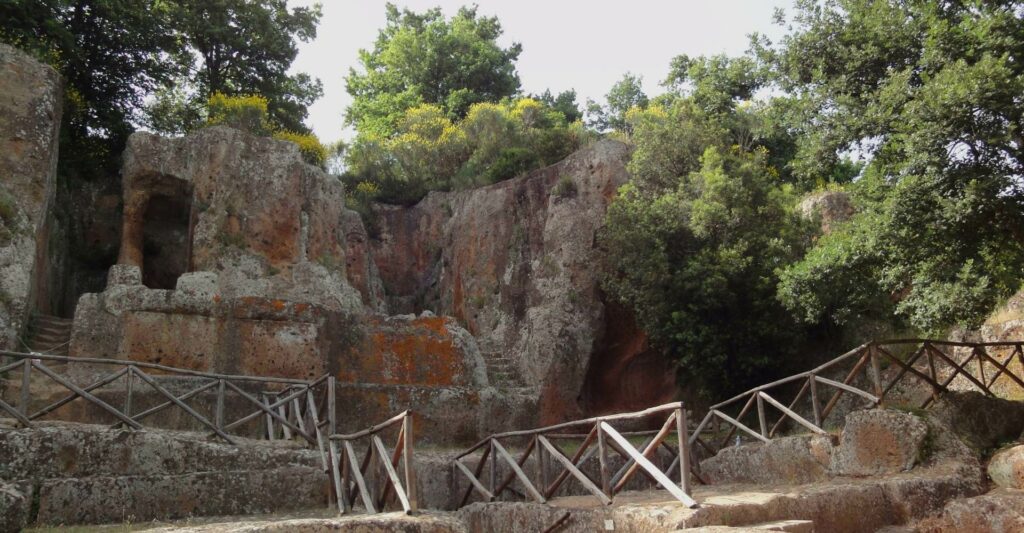
City of tuff archaeological park
The Città del Tufo archaeological park is in turn composed of three areas of interest located in the municipal territory of Sorano: the Etruscan necropolis of Sovana, the rock settlement of San Rocco and the rock settlement of Vitozza, in addition to the Museum of San Mamiliano (in Sovana) and the Civic Archaeological Museum Fortezza Orsini (in Sorano).
The part that concerns Sovana is located a few kilometers beyond the town on the road that connects the village to San Martino sul Fiora. Here is the entire area of the Necropolis, a historical heritage of inestimable value made up of tombs and mysterious vie cave.
The first part of the necropolis extends for about a kilometer and a half and has an almost uninterrupted row of cube and semi-cube tombs.
Among these, some monumental tombs with colonnaded fronts and aedicule with decorated pediments stand out: in Poggio Prisca (Pola tomb and tomb of the Winged Demons); in Poggio Felceto (Ildebranda tomb); at Poggio Staenziale (Typhon’s tomb).
The Ildebranda tomb (3rd-2nd century BC) is probably the most famous of the entire Necropolis. Completely dug into the tuff, it looks like a monumental temple with a six-column portico. The burial chamber, in which a single storage platform for the deceased has been carved, can be reached via a long central corridor going downhill. The room was found completely empty, the result of ancient looting or the action of grave robbers. The name was given in honor of Hildebrand of Soana, better known as Pope Gregory VII. The tomb was made known by Gino Rosi in 1925, who published a first account of it.
Passing the Typhoon’s tomb and following the signs you arrive at a large Via Cava called “Il Cavone”. If the history of the vie cave in the area is shrouded in mystery, that of Cavone, given its size, is even more so. About one kilometer long and two to four meters wide, the Cavone can be considered a highway compared to the other vie caves in the area of Sorano and Pitigliano which are much shorter and above all narrower.
The Vie Cave are works of Etruscan origin that are unique in the world, a heritage of enormous historical-cultural importance and arouse an irresistible attraction. Between the area of Sorano and Pitigliano there are a few dozen of them and they vary in size (the Cavone in Sovana is certainly the largest). They can be explored on foot or on horseback and walking along these paths offers great suggestions. Why the Etruscans built these streets carved into the tuff is still a mystery today, some hypothesize a sacred and funerary use (they are almost always close to necropolises), other theories claim they were simple connecting routes or even works for the flow of water. The only certainty is that they must have been of considerable importance (it is estimated that 40 thousand tons of volcanic rock were removed just to build the Cavone).
After visiting the first sector of the necropolis (Tomba Ildebranda) you can proceed on foot along the pedestrian path that runs alongside the SP22 towards Sovana.
After about two hundred meters you arrive at the second sector of the Necropolis which includes the Church of San Sebastiano, the Tomb of the Mermaid (the most important), the Semidado Tombs and the Via Cava of San Sebastiano.
The tomb of the Mermaid (III-II BC), is located at the top of a rise and is an aedicule tomb entirely dug into the tuff. The façade reproduces a false door, inside which the image of the deceased represented as a symposiast is carved, the door is guarded on the sides by two demons, probably Charun and Vanth. The name derives from the frieze which does not represent a mermaid, as commonly known, but the sea monster Scylla caught in the act of sinking a ship. Above the image of the deceased the writing “Vel Nulina”, “Son of Vel”, is clearly legible. A particularly narrow dromos leads to the burial chamber, which is offset from the aedicule. The small size of the chamber suggests a burial for a single individual. The tomb was first described by the English painter Samuel Aisnley who was directed there by the locals.
Continuing on this path, you reach the necropolis of San Sebastiano, where you can cross the Vie Cave of the same name which cuts through some chamber tombs from the archaic age to finally reach a rock oratory with two rooms.
Hours
- Continuous opening hours every day 10:00-19:00 (last entry allowed at 18:00)
Tickets
- Full ticket €5.00;
- Reduced ticket €3.50
- Cumulative ticket: €10.00 includes entrance fees to the “Città del tufo” archaeological park, to the Museum of the Middle Ages with the Orsini Fortress and to the Sovana Museum Complex with the San Mamiliano Museum


